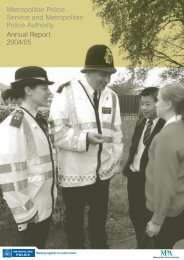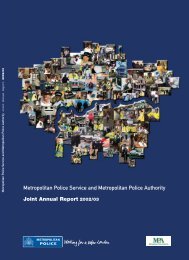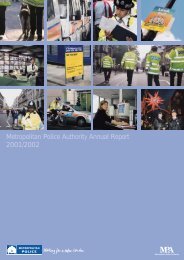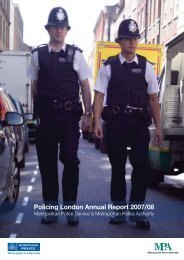The MPA/MPS Estate Strategy - Metropolitan Police
The MPA/MPS Estate Strategy - Metropolitan Police
The MPA/MPS Estate Strategy - Metropolitan Police
- No tags were found...
Create successful ePaper yourself
Turn your PDF publications into a flip-book with our unique Google optimized e-Paper software.
THE <strong>MPA</strong>/<strong>MPS</strong> ESTATE STRATEGY2010-2014
1. Context: challenges facing the<strong>Metropolitan</strong> <strong>Police</strong> Service<strong>The</strong> <strong>Metropolitan</strong> <strong>Police</strong> Service (<strong>MPS</strong>) serves a population of over 7.5 million living in an area of1,579 sq kms. <strong>The</strong> population is expected to rise to 8.1 million by 2016 and as well as residents,London has a significant number of commuters and visitors who impact on the dynamics of the city.Policing in London is a 24 hour/7 days a weekoperation delivered by over 50,000 people.Each year the <strong>MPS</strong> deals with 7 million telephonecalls and recorded crimes are in the order of830,000 a year.<strong>The</strong> <strong>MPS</strong> aims to build public safety andconfidence by:• Convincing communities we are on theirside.• Reducing crime and catching criminals.• Being intolerant of violence.• Delivering security on the streets of London.• Delivering the right services at the rightprice.<strong>The</strong> <strong>MPS</strong>’s mission is “to make London thesafest major city in the world”. What needs to bedone and how the <strong>MPS</strong> works as an organisationto deliver that mission over the medium term canbe summarised as follows:To deliver SAFETY and CONFIDENCEOur PRESENCE must be felt across LondonOur PERFORMANCE must be outstandingOur PRODUCTIVITY must be high, andOur PROFESSIONALISM must be a cause forPRIDE<strong>The</strong> <strong>MPS</strong> vision is supported by the corporatethemes of safety, confidence and improvement.Bromley <strong>Police</strong> Station - a modern multi-purpose buildingSafetyIn promoting safety for those who live, work andvisit London, the <strong>MPS</strong> is committed to reducingcrime and catching criminals, being intolerant ofviolence and delivering security on the streets ofLondon.Confidence<strong>The</strong> <strong>MPS</strong>, in all that it does, is working to convincecommunities in London that it is on their side andto improve people’s experience of its services.Improvement<strong>The</strong> <strong>MPS</strong> aims to provide the right services at theright price thus ensuring the efficient, effectiveand economic use of all the resources entrustedto it.More details about theses themes can be foundon the <strong>MPA</strong> and <strong>MPS</strong> websites, notably in the<strong>MPA</strong>/<strong>MPS</strong> Policing Plan and the <strong>MPA</strong> MetForward documents.www.mpa.gov.ukNew Scotland Yardwww.met.police.ukPage 4 | THE <strong>MPA</strong>/<strong>MPS</strong> ESTATE STRATEGY THE <strong>MPA</strong>/<strong>MPS</strong> ESTATE STRATEGY | Page 5
2. How do we police London?London is a vibrant international city, home to7.6 million people and many languages. Millionsmore work in, and visit, the city each year. It isa multi-layered world, shifting shape and sizeconstantly.<strong>The</strong> <strong>MPS</strong> protects London 24 hours a day. It is asdynamic as the city and is geared to respond tothe public’s calls for help, and to threats to publicsafety, from wherever they emerge.<strong>The</strong> <strong>MPS</strong> makes its presence felt when andwhere it matters. Its workforce of more than32,000 police officers, over 4,000 <strong>Police</strong>Community Support Officers (PCSOs) and over14,000 support staff work across a number ofinter-linked levels.<strong>The</strong> <strong>MPS</strong>’s interaction with the public takes placein a number of different ways:• Command Control Call Centres taketelephone calls and may be the first point ofcontact for some people.• Front counters offer face to face contactfor those reporting crime or collecting andreturning forms.• Safer Neighbourhoods bases serve localwards.• Kiosk/information points with touch screenslinked to the local team can be found inshopping centre locations.• Mobile police stations serve local communitiesas required.• <strong>The</strong> <strong>MPS</strong> is also contactable by email andemergency and non emergency telephonenumbers.• In wards and neighbourhoods, the <strong>MPS</strong>is present in local policing teams. Londonhas 625 electoral wards, each with around20,000 households. Every ward has a localteam which enhances police presence inlocal communities.• In the 32 geographical borough commands,which match local authority boundaries, the<strong>MPS</strong> organises its 999 response teams andruns local Criminal Investigation Department(CID) teams. Borough Commanders are thelink with councils and other agencies.• On a pan-London level, the <strong>MPS</strong> runs murdersquads, public order units, firearms teams,forensics support and other highly trainedspecialist units required to police a modernmajor city, such as squads to target drugtraffickers.• London has one of the world’s busiesttransport networks. <strong>The</strong> <strong>MPS</strong> operates a pan-London Safer Transport Command, whichworks closely with British Transport <strong>Police</strong>and Transport for London, and road policing.• In the sphere of terrorism, the work by policeand other agencies at grass-roots level, withyoung people in schools and youth clubs inLondon, may be the key to disrupting theplans of terrorist groups based thousands ofmiles away. Counter-terrorist investigatorsfind their inquiries stretching from a Londonneighbourhood to the international arena.• <strong>The</strong> work at all these levels, from ScotlandYard specialist units to PCSOs, is part of anintegrated approach, because the criminalsand those who threaten the safety of thepopulation recognise no levels or boundaries.• Much of what the <strong>MPS</strong> does is visible andovert. Its uniformed response teams turn up to999 calls from the public. In neighbourhoodsand town centres across London, the <strong>MPS</strong>provides a visible, uniformed and reassuringpolice presence.• At a national and international level, the <strong>MPS</strong>leads the British policing response to terrorismand protects politicians, the royal family andvisiting heads of state. It is an important playerin the fight against international organisedcrime.A Met <strong>Police</strong> vehicle patrolling LondonPage 6 | THE <strong>MPA</strong>/<strong>MPS</strong> ESTATE STRATEGY THE <strong>MPA</strong>/<strong>MPS</strong> ESTATE STRATEGY | Page 7
• <strong>The</strong> <strong>MPS</strong> is on display to the world as itsuniformed officers police more than 4,500public order events each year, ranging fromthe Notting Hill Carnival, through to footballmatches and the planned policing of the 2012London Olympic and Paralympic Games.• However, much of its most importantprotective work is ‘invisible’. <strong>The</strong> public maybenefit from a safer London but will not seethe work of counter-terrorist detectives,child protection teams, e-crime specialists,surveillance units and other specialistsquads, or the work <strong>MPS</strong> officers and staffcarry out to ensure offenders are put into thecriminal justice system.• Some of the property the <strong>MPS</strong> uses is publiclyidentifiable and visible. Many responseofficers and some neighbourhood teams arebased in ‘traditional’, multi-functional policestations, alongside custody suites and CIDunits.• However, in recent years, neighbourhoodteams have been based in non-policepremises, including council offices. <strong>The</strong> keyis to be based in or very close to their wards.• Increasingly, as older buildings are replaced,the emphasis is on ensuring police officersare based in locations which allow themto get to the public, in need and distress,as quickly as possible. This may meanbuilding separate custody bases and puttingresponse or local policing teams in premisesat the heart of the areas they police.• <strong>Police</strong> officers and staff do not wait instations for calls to respond to. <strong>The</strong>y areout, on the streets and in communities,patrolling. Increasingly, with police officerspatrolling on their own, the ‘footprint’ theycover in London is bigger.• What matters is not the buildings theofficers gather in for their shifts or theirlocations, but that they are well-briefed andthat they know their areas. What matters isthat they have the right equipment to getto the public, when they are needed, asquickly as possible.• Equally, some of the <strong>MPS</strong>’s most vitalunits , such as surveillance teams workingagainst armed gangsters, are in anonymousbuildings.• Working at a computer, in an office, toidentify those cyber-trafficking child abuseimages may lead to the rescue of childrenin London from abuse. Invisible, covertpolicing plays a major role in keepingLondon safe.• Increasingly, the handling of detainees incustody is moving from the older, traditionalstations to purpose built custody centres.This will make little difference to the publicwhose main concern is that offenders arearrested.• <strong>The</strong> key to all of the <strong>MPS</strong>’s plans is thatit can get to people who need its helpquickly, where and when it counts, and thatpeople are able to call on it for help - byphone, SMS, email, across the internet orin person.A visible presence on the streets of London, maintainingPage 8 | THE <strong>MPA</strong>/<strong>MPS</strong> ESTATE STRATEGY the safety and confidence of the communityTHE <strong>MPA</strong>/<strong>MPS</strong> ESTATE STRATEGY | Page 9
3. Context: challenges facing the<strong>Metropolitan</strong> <strong>Police</strong> estateOverall responsibility for the estate is vested in the <strong>Metropolitan</strong> <strong>Police</strong> Authority (<strong>MPA</strong>), the statutoryorganisation responsible for ensuring an efficient and effective police service for London. Day-todaymanagement of the estate is delegated by the <strong>MPA</strong> to the <strong>MPS</strong> which occupies the estate. <strong>The</strong>Property Services Department, within the Resources Directorate, has delegated responsibility forthe management of the estate.<strong>The</strong> estate currently comprises just under 1,000,000 sq m and in the order of 900 buildings. It canbe categorised in various ways but from a public perspective the most important differentiation isbetween public facing and non-public facing functions.Public facing facilities include places where the public can make face to face contact with policeofficers whether they are victims or witnesses of crime, offenders, or using the police services inanother way.Non-public facing facilities include police training facilities, forensic research establishments, callcentres and office buildings for the <strong>MPS</strong> business support services (finance, human resources, etc).<strong>The</strong> <strong>MPS</strong> also has residential facilities including blocks of flats, individual houses and single flats,or hostel style ‘section house’ accommodation allocated under specific criteria to staff and officers.<strong>The</strong> key challenges facing the estate are:• Responding to the speed of change and the increasingly dynamic nature of policing.• Having the right buildings, of the right size, in the right place.• Being able to accommodate new policing operations at short notice.• Accommodating new functions into existing buildings without disrupting current operations.• Working with a range of other public sector partners.• Working within increasingly difficult financial constraints and ensuring the <strong>MPS</strong> is making thebest use of its assets.A Met <strong>Police</strong> vehicle patrolling LondonEmpress State BuildingPage 10 | THE <strong>MPA</strong>/<strong>MPS</strong> ESTATE STRATEGY Houses a range of operational and non-operational functionsTHE <strong>MPA</strong>/<strong>MPS</strong> ESTATE STRATEGY | Page 11
4. Meeting the challenge5. <strong>The</strong> property visionAlong with people, information technology and vehicles, property is one of the key resources whichsupports operational policing. To ensure efficiencies in the use of property, the <strong>MPA</strong> and the <strong>MPS</strong>regularly review their <strong>Estate</strong> <strong>Strategy</strong> and supporting plans for implementing it.In the last few years the <strong>MPS</strong> has concentrated on the provision of Safer Neighbourhoods bases,new custody facilities and new patrol bases across the capital. Whilst the estate has expanded interms of numbers of buildings, selected properties have been sold where they are no longer neededfor operational delivery.VISIONContinually improving the use of the estate.We will optimise the use of the estate to achieve <strong>MPA</strong>/<strong>MPS</strong> objectivesthrough prioritised spending and ensuring value for money. We will achievethis using a framework that supports inclusion and recognises the diversityof the communities we service.<strong>The</strong> Property Services team supports the <strong>MPA</strong> and <strong>MPS</strong> in the strategic planning, delivery,management and operation of the estate. <strong>The</strong> Property vision is in line with other public bodies withan operational or service focus, where property is a supporting function. <strong>The</strong> planning, delivery,operation and review of property must flow from the operational need. However, this does not stopthe <strong>MPS</strong> from challenging and reviewing the operational need to ensure value for money from itsresources. <strong>The</strong> aim is to provide a well planned property portfolio which:Enfield Patrol Base<strong>The</strong> <strong>MPA</strong> and the <strong>MPS</strong> now need to rationalise the estate to ensure it meets service needs in themost cost effective manner. <strong>The</strong> <strong>MPS</strong> will work to agreed space standards and co-locate functionsin order to operate from fewer properties, but will ensure that it maintains operational policingcapability.<strong>The</strong> current <strong>Estate</strong> <strong>Strategy</strong> comprises three core elements:• Meets current and future service needs interms of confidence, safety and value formoney.• Is in good condition with minimal maintenancebacklog.• Rationalises property wherever possiblein line with future needs (e.g. crime, risks,changing population, growth areas, changingpatterns of service delivery, work style of the<strong>MPS</strong> staff).• Provides working conditions that supportgood service performance.• Capitalises upon co-location opportunitieswithin London and exploits the synergies ofpartnerships.• Releases capital for reinvestment whereappropriate.• Is regularly reviewed using agreed criteria.• Allocates investment in future propertyaccording to a robust corporate prioritisationframework.• Continues to drive energy efficiency anduphold high environmental standards.• <strong>The</strong> Property vision.• Property objectives.• Key themes for change and targets.In addition, the <strong>MPS</strong> has a range of implementation plans.Page 12 | THE <strong>MPA</strong>/<strong>MPS</strong> ESTATE STRATEGY THE <strong>MPA</strong>/<strong>MPS</strong> ESTATE STRATEGY | Page 13
7. Framework for estate change7.1 Real estate: fit for purpose estate<strong>The</strong> framework for change consists of:• Real estate - the physical estate and buildings.• Process - the process change required to support an effective and efficient estate.• Service - how Property Services, together with colleagues from across the <strong>MPS</strong>, respond tothe estate challenges.Condition<strong>The</strong> current operational estate is highlydiversified and has a significant backlog ofmaintenance issues. <strong>The</strong> ongoing programmeof condition surveys will ensure that the <strong>MPS</strong>updates the backlog costs and provide a revisedprogramme of repairs, redevelopments andbuilding disposals.Sufficiency<strong>The</strong> <strong>MPS</strong> has an ongoing programme to gaugethe size of the estate relative to the operationalneeds. It has also developed policies that allowit to provide suitable front counter facilities orreception areas and Safer Neighbourhoodsbases for the communities it serves.Capital programme<strong>The</strong>re is an ongoing programme of new buildingdevelopment to replace the older and unsuitablebuildings in the estate. A matrix, which prioritisesnew capital projects against the Policing LondonBusiness Plan’s priorities, has been developed.SuitabilityIn a number of cases, buildings are not beingused for the original purpose they were designedfor. <strong>The</strong> <strong>MPS</strong> is therefore pursuing a programme,as new buildings come on stream, to movebusiness units to more fit for purpose premises.A planned exit strategy has already beendeveloped in regard to the residential estate,where it is anticipated that core property holdingswill be a maximum of 200 units.Property Services are developing workprogrammes to optimise the utilisation and reprofilingof the estate. Part of this programme isthe development of appropriate standards andprotocols for the use of property.To deliver a leaner, more effective estate,business processes and operational demandare being analysed within properties primarilyused for office, storage and training purposes.<strong>The</strong> overarching aim is to meet operationalneed while reducing cost and generating capitalreceipts which can be invested in operationalpolicing and public facing buildings.Wapping Pontoon and <strong>Police</strong> Stationhouses the <strong>Metropolitan</strong> <strong>Police</strong> river fleetPage 16 | THE <strong>MPA</strong>/<strong>MPS</strong> ESTATE STRATEGY THE <strong>MPA</strong>/<strong>MPS</strong> ESTATE STRATEGY | Page 17
7.2 ProcessCorporate Real <strong>Estate</strong> approach<strong>The</strong> <strong>MPS</strong> has moved to a more corporateapproach to the planning, delivery, operationand use of property. Property Services are theprofessional lead for real estate and will advise<strong>MPS</strong> Management Board so that property relateddecisions can be taken in the overall corporateinterest of the service. All business groups havebeen consulted and are supportive of this strategywhich will help to bring about more effective useof property.Property Services are also putting the CorporateReal <strong>Estate</strong> approach at the heart of the deliveryof property services within the organisation.CollaborationIn financially challenging times it is even moreimportant that the <strong>MPS</strong> works closely with otherpublic agencies and private sector partners and,where practical, looks to share services withpartners.Its key regional public partners are the othermembers of the Greater London Authority -Transport for London in particular.At a local level the <strong>MPS</strong> interfaces with theborough councils and the Primary Care Truststhrough the Local Strategic Partnerships (LSP).Through the Safer Neighbourhoods programmethe <strong>MPS</strong> has located a number of units withinassets owned by other public partners, e.g. localauthorities. <strong>The</strong> <strong>MPS</strong> is keen to continue thisinitiative so it is currently working with a numberof London councils to develop joint solutions tosome of its property challenges.Criteria for retention, rationalisation and acquisition of propertyTo achieve value for money in its estate and reach optimal cost levels, the <strong>MPS</strong> needs to be thoroughin challenging its need for property and its intensity of use.<strong>The</strong> <strong>MPS</strong> recognises that it will need to provide for the property and accommodation needs ofexisting, new and improved public services and the needs of its workforce. At the same time itneeds to release significant capital from, and reduce the revenue costs of, the estate. This will bedone through regular service property reviews and area property reviews. <strong>The</strong> <strong>MPS</strong> has a decisionmatrix to determine whether to hold or dispose of properties and this is continually reviewed againstthe changing operational policing priorities. Whilst the criteria are continually reviewed, particularlyoperational related matters, the issues under consideration include, but are not limited to:• Impact on operational capability (e.g. single site patrolling, custody provision, front counterprovision).• Annual revenue costs.• Projected capital investment.• Public footfall (where appropriate).• Carbon footprint / energy performance/ Display Energy Certificate (DEC) rating.• Utilisation of facilities / workspace.• Options for lease termination.• Availability of alternative building solution.• Presence of Information, Communications and Technology (ICT) notes.• Current building condition.• Building and location suitability.<strong>The</strong> <strong>MPS</strong> also has priority lists for new capital projects which are reviewed against agreed criteria.This results in a comprehensive investment plan for property.Corporate Social Responsibility (CSR)As with town planning, the <strong>MPA</strong> and the <strong>MPS</strong> are developing a separate CSR strategy. <strong>The</strong> <strong>MPA</strong> andthe <strong>MPS</strong> have a very strong commitment to the principles of social, economic and environmentalsustainability. <strong>The</strong>se are corporate responsibilities which business units uphold and the ResourcesDirectorate, including Property Services, drive through the estates vision, strategy and plans.Safer NeighbourhoodsBase - BromleyIn the long term re-profiling of the estate, the following are being taken into account:• Energy costs of buildings.• Responsibilities towards Carbon Reduction Commitment (CRC).• Travel patterns of the public as well as employees .• Environmental targets set by central government as well as the Greater London Authority (GLA).Page 18 | THE <strong>MPA</strong>/<strong>MPS</strong> ESTATE STRATEGY THE <strong>MPA</strong>/<strong>MPS</strong> ESTATE STRATEGY | Page 19
7.3 ServiceOlympics and the Thames Gateway<strong>The</strong> London 2012 Olympic and ParalympicGames and the Thames Gateway are twosignificant programmes of work. <strong>The</strong> <strong>MPS</strong> has anOlympic Programme team as well as a ThamesGateway Programme Board. <strong>The</strong> <strong>MPS</strong> is closelymonitoring any new processes and operationalplans being adopted in these two programmesand feeds any improved processes, systemsand ideas into its future plans.Multiple clients, single source ofadviceProperty Services’ current structure providesfor a dedicated single point of contact for each<strong>MPS</strong> business group. Through these individuals,the <strong>MPS</strong> coordinates the collective operationaldemands of the service so it can plan the estateon a corporate basis. This way it can bring aboutsynergies across the various <strong>MPS</strong> businessgroups.Value for money<strong>The</strong> <strong>MPS</strong> is very focussed on achieving yearon year value for money improvements in theestate. Driven by the need to make better useof the estate, it should be able to reduce its sizewhich in turn will drive down running costs andrelease surplus assets for disposal.Town planning<strong>The</strong> <strong>MPS</strong> has a separate town planning strategy- Planning for Future <strong>Police</strong> <strong>Estate</strong> Development.Town planning is an important tool for the <strong>MPS</strong> touse in a proactive as well as a reactive way. <strong>The</strong><strong>MPS</strong> articulates to regional and local governmentthe policing demands in terms of property. It alsoresponds to requests from local authorities onlarge scale development opportunities where thedevelopment justifies a dedicated police facilityor contribution to the local policing function. <strong>The</strong><strong>MPS</strong> therefore influences the Mayor’s LondonPlan as well as individual borough’s LocalDevelopment Frameworks (LDF).Under the Secure by Design initiative the <strong>MPS</strong>has a number of Crime Prevention DesignAdvisors, who provide input at a design stageinto large scale regeneration projects.<strong>The</strong> <strong>MPS</strong> will continue to input into the emergingCommunity Infrastructure Levy (CiL).<strong>The</strong> <strong>MPS</strong> strives to develop as well as followbest practice in everything it does. It participatesin a number of property industry groups, aswell as police specific groups, which shareand disseminate these skills and information. Ithas also shared with the Home Office some ofits evolving design standards and, through itsrelationship with Transport for London, sharesinformation and good practice.A new Custody Centre - Waltham ForestPage 20 | THE <strong>MPA</strong>/<strong>MPS</strong> ESTATE STRATEGY THE <strong>MPA</strong>/<strong>MPS</strong> ESTATE STRATEGY | Page 21
8. Performance measurement andimprovementTo support the objectives and key themes the <strong>MPS</strong> has a range of implementation plans. <strong>The</strong> <strong>MPS</strong>will:Glossary• Set targets and the owners allocated will monitor progress on these commitments. <strong>The</strong>se will bereported through our performance monitoring framework.• Have a strong commitment to improving data collection, systems and management. It is reviewingits internal data management systems and will determine future need against this strategy.• Continue to conduct post occupancy evaluation of all programmes and projects to ensure benefitsare being realised and lessons are fed back into new programmes.In addition to these internal measures, the <strong>MPS</strong> takes part in a number of voluntary and mandatorybenchmarking exercises. Through the <strong>Police</strong> Property Managers Group and its internal systems, the<strong>MPS</strong> will continue to monitor the performance of the estate.CiLCRCCSRDoRFMGLAHMICHRICTKPILSP<strong>MPA</strong><strong>MPS</strong>PSDSIPTfLCommunity Infrastructure LevyCarbon Reduction CommitmentCorporate Social ResponsibilityDirectorate of ResourcesFacilities ManagementGreater London AuthorityHer Majesty's Inspectorate of ConstabularyHuman ResourcesInformation Communications TechnologyKey Performance IndicatorLocal Strategic Partnership<strong>Metropolitan</strong> <strong>Police</strong> Authority<strong>Metropolitan</strong> <strong>Police</strong> ServiceProperty Services DepartmentService Improvement ProgrammeTransport for LondonContactDirector of Property Services<strong>Metropolitan</strong> <strong>Police</strong> Service Property Services12th Floor, Empress State BuildingEmpress ApproachLillie Road, Earls CourtLondonSW6 1TRPage 22 | THE <strong>MPA</strong>/<strong>MPS</strong> ESTATE STRATEGY THE <strong>MPA</strong>/<strong>MPS</strong> ESTATE STRATEGY | Page 23
Page 24 | THE <strong>MPA</strong>/<strong>MPS</strong> ESTATE STRATEGY





![Appendix 1 [PDF]](https://img.yumpu.com/51078997/1/184x260/appendix-1-pdf.jpg?quality=85)

![Transcript of this meeting [PDF]](https://img.yumpu.com/50087310/1/184x260/transcript-of-this-meeting-pdf.jpg?quality=85)
![Street drinking in Hounslow [PDF]](https://img.yumpu.com/49411456/1/184x260/street-drinking-in-hounslow-pdf.jpg?quality=85)







